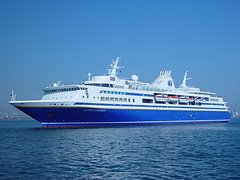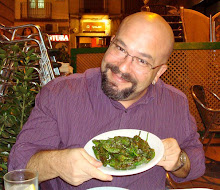OK. Chile. But, first things first. My last post elicited comments from two former lurkers, Katy and Kassia. As a reward for their comments, I offer the following pictures of the synchronized swimming routine in which I participated as part of the ship’s Sea Olympics:

John, the Executive Dean, and I, preparing to enter the frigid water of the pool for our synchronized swim. Note the stylish shower caps. Despite our proximity to the equator at this point, the outside temperature was in the 60's, at best. The routine was designed to delay our entrance into the water as long as possible. Musical accompaniment: "Play that Funky Music White Boy."

Here we are in the water. Note the clockwork synchronicity of our routine. Oddly, we didn’t even place!
Note, other lurkers, that commenting is rewarded! Post your thoughts, your reactions, or your just your hellos!
Now, Chile. As usual, Zoë has beaten me to the punch with the pictures and the blow-by-blow of our memorable trip to San Pedro de Atacama, so I will limit myself, as usual, to editorializing. Her post should vividly demonstrate how spectacular are the landscapes near San Pedro, the salt flats, the Valley of the Moon, the Tatio geysers, the altiplano. “Beauty” is not the right word for it, since it suggests something attractive, hospitable, perhaps even inhabitable. This landscape, by contrast, was shockingly desolate and hostile, even exhausting. The sky is big, and the horizon far. Mountains that are over 150 kilometers away are the only thing there to arrest your line of sight, and there comes a point when such expansive views become overwhelming. This happened for me when we emerged from the salt cave in the Valley of the Moon, and all of a sudden found our eyes traveling many kilometers rather than mere meters. That afternoon, we spent some time in the hotel lounge reading, and in town shopping. In part it was just because we were tired and needed downtime, but I also think we felt this need for enclosure, for shelter. Very strange. The Kid and I bought San Pedro t-shirts, while Zoë picked up some great copper earrings.
Now, what I had expected were the hippies. San Pedro is one of a series of towns scattered around Latin America – San Cristóbal de las Casas, Mexico, Panajachel, Guatemala, Baños de Tungurahua, Ecuador, are some others – that are linked together by a route of backpacker tourism known as “the gringo trail.” I find these places delightful. In these towns, tourists seem to outnumber locals, and even the “locals” are often transplants from other parts of the country. The draw of such places, for both foreigners and domestics alike, is not just the surrounding scenery, but the relaxed lifestyle that unfolds in these towns underneath the protective umbrella of patchouli and marijuana smoke. In San Pedro, it’s hallucinogenic substances, the ones used by atacameño shamans over the 14,000 years that the place has been continually inhabited by human beings. First the atacameños, then the Inca, then the Spanish, and now the hippies. French hippies. US hippies. German hippies. Spanish hippies. Argentinian hippies. Chilean hippies. They rode around on bikes in tie-dye and seemed completely unfamiliar with a product called “shampoo,” but they seemed harmless and were often quite friendly. Many of them have day jobs at little restaurants with impressively slow service, shoddy roofs (who needs a roof in a place where it never rains?) and dining-room fireplaces. One of them, Beth, included a lovely translation for “jamón de pavo.” Rather than “turkey ham,” it called it “turkey jam.” The Kid later made up a commercial jingle for “turkey jam.” We sought out neither hallucinogenic drugs nor meat-based preserves, but we were willing to wait quite a long time in a chilly San Pedro restaurant for some dulce de leche crêpes. They were almost as other-worldly as the Valley of the Moon itself.
Our long return voyage to Valparaiso culminated in a delicious dinner at a place called the Café Turri, a somewhat touristy but delicious restaurant that overlooks the bay in this charming, bohemian city. It was nice to be in a restaurant where we didn’t have to keep our coats on. Unfortunately, our flight back from San Pedro was delayed, so we didn’t get to see much more of the place, and completely missed Pablo Neruda’s house in town. Another time, I’m sure.
Now, on the eve of our arrival in Peru, Pablo Neruda is all the rage. The field trip to his home on Isla Negra, Chile, was a huge hit. Apparently, all involved read and discussed his poetry on the bus on the way there, and then saw things in the house that resonated with the imagery. (I wasn’t on it, since it conflicted with our trip to the Atacama.) Brian has put an English translation of selections from Neruda’s The Heights of Machu Picchu, for everyone to print out and take with them to the ruins. In the computer lab, people are printing out the pages, and folding them up to take with them. I plan to take a copy myself …
Tomorrow, though, it’s Lima, and our S@S excursion, “Colonial Lima Through a Historian’s Eyes.” No one can tell me who the historian will be. It’s not Brian, or any of the S@S faculty. I hope that by “historian” they don’t mean a regular old tour guide who did well in Peruvian history while in high school … In any case, we plan to dump the tour somewhere in downtown Lima so we can eat out, and perhaps even catch the new Harry Potter movie. Not very Peruvian, but vastly important, particularly to the Kid. Post if you’ve seen it, and tell us what you thought of it. OK?

















